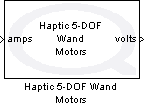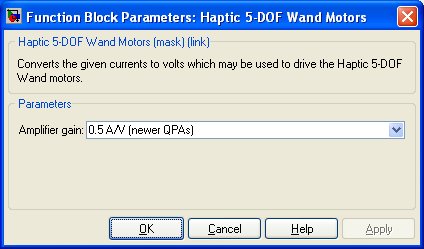

Haptic 5-DOF Wand Motors
Converts motor currents to D/A voltages that may be used to drive the motors of the Quanser Haptic 5-DOF Wand.
Library
QUARC Targets/Devices/Quanser/Haptics/Pantographs/Haptic 5-DOF Wand/Interfacing MATLAB Command Line Click to copy the following command line to the clipboard. Then paste it in the MATLAB Command Window: qc_open_library('quarc_library/Devices/Quanser/Haptics/Pantographs/Haptic 5-DOF Wand/Interfacing')
Description

The Haptic 5-DOF Wand Motors block converts motor currents in amperes to D/A voltages that may be used to drive the motors of the Quanser Haptic 5-DOF Wand. Use one of the HIL blocks to write to the analog outputs connected to the amplifiers of the Quanser Haptic 5-DOF Wand. The motor currents should be input as a 6-vector in the following order of the joints: top-left-small, top-right-small, bottom-left-small, bottom-right-small, top-big, bottom-big. The motor currents are dynamically saturated so that peak currents are allowed for a brief time to get rigid haptic effects, but the currents are then reduced to prevent damage to the device.
For the Quanser Q8 card, analog output channels 0 through 5 are typically used to write to the six joint motors of the Quanser Haptic 5-DOF Wand, with channels 0 through 5 corresponding to the joints in the required order of top-left-small, top-right-small, bottom-left-small, bottom-right-small, top-big, bottom-big respectively.
Input Ports
amps
The currents to drive the motors of the six joints in amperes. The currents must be input as a 6-vector in order of the joints, i.e., top-left-small, top-right-small, bottom-left-small, bottom-right-small, top-big, bottom-big.
Output Ports
volts
The voltages required at the analog outputs to produce the desired motor currents for the six joints. The voltages are output as a 6-vector in order of the joints, i.e., top-left-small, top-right-small, bottom-left-small, bottom-right-small, top-big, bottom-big.
Data Type Support
This block supports inputs and outputs of type double.
Parameters and Dialog Box

Amplifier gain
The gain of the QPA amplifiers driving the Haptic 5-DOF Wand. The gain of these amplifiers has changed in the latest version of the QPA. Newer QPAs will have a sticker indicating the new gain. Look for this sticker to determine whether you have a new QPA amplifier or not. Amplifiers sold in 2008 or later are likely configured for the new gain of 0.5 A/V. If you are not sure, it is safer to start with the old amplifier gain of 2 A/V because that will produce a lower current if the QPA is actually new.
Targets
|
Target Name |
Compatible* |
Model Referencing |
Comments |
|---|---|---|---|
|
Yes |
Yes |
||
|
Yes |
Yes |
||
|
Yes |
Yes |
||
|
Yes |
Yes |
||
|
Yes |
Yes |
||
|
Yes |
Yes |
||
|
Yes |
Yes |
||
|
Yes |
Yes |
||
|
Yes |
Yes |
||
|
Yes |
Yes |
||
|
Yes |
Yes |
||
|
Yes |
Yes |
||
|
Yes |
Yes |
||
|
Yes |
Yes |
Last fully supported in QUARC 2018. |
|
|
Rapid Simulation (RSIM) Target |
Yes |
Yes |
|
|
S-Function Target |
No |
N/A |
Old technology. Use model referencing instead. |
|
Normal simulation |
Yes |
Yes |
See Also

Copyright ©2025 Quanser Inc. This page was generated 2025-11-01. Submit feedback to Quanser about this page.
Link to this page.